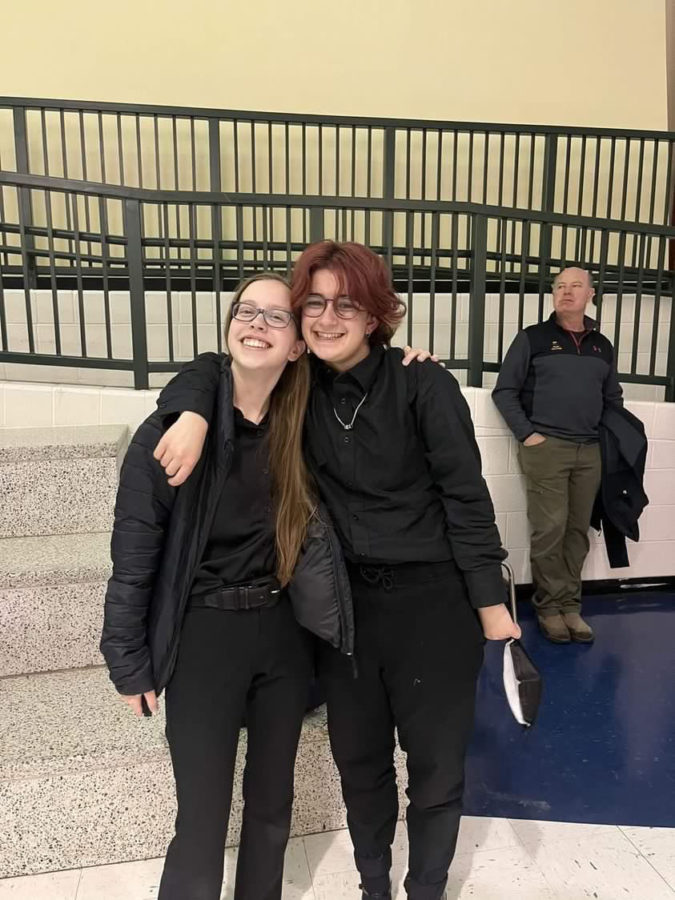Prom is the fashion highlight of the year, with students giving their all to make the ultimate stylistic statement of their school careers. There are infinite variations to choose from, yet nearly every student falls broadly into one of two choices: a dress or a suit. This gendered binary leaves out many students who do not always associate themselves closely with either masculinity or femininity, or do not want to be viewed as a certain identity merely for their clothing selection.
“I feel like formal wear is really gendered. In terms of everyday clothes, you can get away with a lot, but, for example, if you’re assigned female at birth [AFAB] and you wear a suit, you definitely get noticed. When you wear formal wear differently than the way certain people think you should wear it, it’s making a statement. You can’t just do it because you like the way it looks,” senior Frankie Grimaldi said.
There are many different perspectives on how to adapt formal fashion to queer people, or if it should even be adapted at all considering how entrenched it is in gender stereotypes.
“I think people’s idea of what to do with formal wear is too restrictive; not necessarily the standards themselves. I think there’s an ability that a lot of people haven’t unlocked yet to go outside of their comfort zone and look as stunning as they want to,” Gender and Sexuality Alliance [GSA] president senior Blue Laubach said. “Formal wear is a bit of a silly concept to me. You shouldn’t have to have a reason to dress up. I think the terms ‘professional’ and ‘presentable’ are a little outdated and classist.”
There is a rich history with experimentation with fashion in LGBTQ culture, from the ballroom movement to camp aesthetics, and this is reflected in the often subversive and creative ways that queer people style themselves for formal events.
“I think my queerness definitely informs what I wear to school formals. In the way that I do my makeup, the way that I wear my jewelry and sometimes even my haircut, I feel [I am] very expressive of my queerness and I do that purposefully,” GSA treasurer junior Neena Tavik said.
Even with expanded unisex lines in recent years, the often limiting options for clothing leads queer people to have to go to somewhat unconventional sources to find options that best suit them.
“I think it is sometimes difficult to find clothes or accessories that match with my identity, but I have found that in thrift stores it is a lot easier to find stuff, just because there’s such a wide range of clothes,” Tavik said.
In fact, thrift stores were heavily mentioned by queer students as places to find pieces that meshed with their desired presentation, not just because of their wide variety but also because of their low prices. Another idea was to personally modify clothing to give it a unique touch.
“I sew, so I alter clothes that I find at thrift stores or rummaging through my parents’ old clothes. I really like adding hints of masculinity into feminine outfits; that’s really affirming for me to still be able to be feminine but have other aspects,” Laubach said.
An additional recommendation for a way to push formal fashion forward was to turn backwards for inspiration.
“I enjoy wearing vintage items. I think that helps presenting androgynously. When you dress based on all these different periods and times, the gender kind of gets lost in the mix,” senior Destini Haith said.
While the desire to break down boundaries for fashion is increasing, not everyone may accept the discrepancy between how they think someone should present and how that person wants to themselves.
“I once went to a wedding and I wanted to wear this pantsuit and my mom was like ‘No, you’re wearing a dress,’ and I felt f***ing awful,” Haith said. “[Formal wear is] definitely restrictive, but what I like to do is just ignore it.”
Reflecting this, prom is not always the most accepting event for experimentation or diversion from cultural expectations. As an alternative, Moco Pride runs an annual pride prom, a place where LGBTQ students are encouraged to be authentically themselves and present that through their clothing, as well.
“I think there’s a certain reclaiming of formal wear that happens for queer people. Going to WJ prom [and] then [Pride] prom, it was really interesting to see how the ideas of typical prom wear change going from one to the other. [At Pride prom] it was a lot more flowy; people would bend the conventions, like wearing suits with full makeup looks on,” Grimaldi said. “There were a lot of guys wearing things very flamboyantly, which I don’t think you would see at WJ prom without getting comments. If you’re in a place where you know you’re respected, you’re much more comfortable with what you wear.”
Prom is a culmination of four years of immense growth, a night of celebration of friendship, relationships and yourself. This night is just as important to queer people, but often more difficult for them to be seen in the way they desire. Regardless, they resolve to enjoy it to the best of their abilities.
“I don’t really believe clothes are gendered, so for me I just wear whatever I think I look the best in and what I feel the best in…I just want to feel as pretty and handsome at the same time as possible,” Laubach said.





































